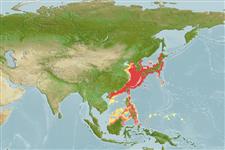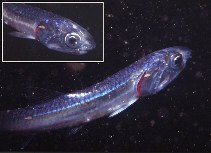Add your observation in Fish Watcher
| Native range | All suitable habitat | Point map | Year 2050 |

|
| This map was computer-generated and has not yet been reviewed. |
| Engraulis japonicus AquaMaps Data sources: GBIF OBIS |
Upload your photos and videos
Pictures | Google imageEngraulis japonicus
Picture by Zsilavecz, G.
Pictures | Google imageEngraulis japonicus
Picture by Zsilavecz, G.
China country information
Common names:
姑仔, 姑仔, 日本鯷
Occurrence: native
Salinity: marine
Abundance: | Ref:
Importance: highly commercial | Ref: FAO, 1994
Aquaculture: | Ref:
Regulations: | Ref:
Uses: no uses
Comments: Known from Bohai in Liaoning Province (Ref. 47439) and from Yantai City and Qingdao City in Shandong Province (Ref. 47439). Also Ref. 559, 42692, 117610.
National Checklist:
Country Information: https://www.cia.gov/library/publications/resources/the-world-factbook/geos/ch.html
National Fisheries Authority:
Occurrences: Occurrences Point map
Main Ref: Whitehead, P.J.P., G.J. Nelson and T. Wongratana, 1988
National Database:
Occurrence: native
Salinity: marine
Abundance: | Ref:
Importance: highly commercial | Ref: FAO, 1994
Aquaculture: | Ref:
Regulations: | Ref:
Uses: no uses
Comments: Known from Bohai in Liaoning Province (Ref. 47439) and from Yantai City and Qingdao City in Shandong Province (Ref. 47439). Also Ref. 559, 42692, 117610.
National Checklist:
Country Information: https://www.cia.gov/library/publications/resources/the-world-factbook/geos/ch.html
National Fisheries Authority:
Occurrences: Occurrences Point map
Main Ref: Whitehead, P.J.P., G.J. Nelson and T. Wongratana, 1988
National Database:
Common names from other countries
Classification / Names ชื่อสามัญ | ชื่อพ้อง | Catalog of Fishes(สกุล, ชนิด) | ITIS | CoL | WoRMS | Cloffa
> Clupeiformes (Herrings) > Engraulidae (Anchovies) > Engraulinae
Etymology: Engraulis: Greek, eggraulis, -eos = anchovy (Ref. 45335).
More on authors: Temminck & Schlegel.
Etymology: Engraulis: Greek, eggraulis, -eos = anchovy (Ref. 45335).
More on authors: Temminck & Schlegel.
Environment: milieu / climate zone / depth range / distribution range นิเวศวิทยา
เกี่ยวกับทะเล,น้ำเค็ม; สัตว์น้ำที่อาศัยและอพยพภายในทะเลเท่านั้น (Ref. 51243); ระดับความลึก 0 - 400 m (Ref. 50550). Temperate; 8°C - 30°C (Ref. 56557); 49°N - 2°N, 105°E - 155°E (Ref. 54432)
การแพร่กระจาย ประเทศต่างๆ | พื้นที่จำแนกตาม FAO | ระบบนิเวศหลายระบบ | การปรากฏขึ้น,การเกิดขึ้น,พบ | Point map | การแนะนำ | Faunafri
Western Pacific: southern Sakhalin Islands, Sea of Japan and Pacific coasts of Japan, and south to almost Canton/Taiwan; rare records (seems to represent stray fishes) off the coasts of Luzon and Western Mindanao, Philippines and from Manado and Ujung Pandang, Sulawesi, Indonesia (Ref. 189).
Length at first maturity / ขนาด / น้ำหนัก / Age
Maturity: Lm 10.5, range 10 - 11 cm
Max length : 18.0 cm TL เพศผู้/กระเทย; (Ref. 56527); common length : 14.0 cm TL เพศผู้/กระเทย; (Ref. 56527); น้ำหนักสูงสุดที่มีการรายงาน: 45.00 g (Ref. 56527); อายุสูงสุดที่ได้รายงาน: 4 ปี (Ref. 56527)
Max length : 18.0 cm TL เพศผู้/กระเทย; (Ref. 56527); common length : 14.0 cm TL เพศผู้/กระเทย; (Ref. 56527); น้ำหนักสูงสุดที่มีการรายงาน: 45.00 g (Ref. 56527); อายุสูงสุดที่ได้รายงาน: 4 ปี (Ref. 56527)
Short description เครื่องมือที่ใช้ในการแยกชนิดสัตว์,สิ่งมีชีวิตออกจากกัน | สัณฐานวิทยา | ความยาวต่างๆ
เงี่ยงครีบหลัง (รวม) : 0; ก้านครีบอ่อนที่หาง (รวม) : 12 - 14; เงี่ยงครีบก้น: 0; ก้านครีบอ่อนที่ก้น: 13 - 18. Differs very little from the European anchovy (see E. encrasicolus) and can be identified from that description. Of other anchovies found in the southern part of its distribution, only species of Encrasicholina and Stolephorus are of similar appearance, but all have small spine-like pre-pelvic scutes (usually 2 to 7 scutes). Thryssa have compressed bodies and a keel of scutes along belly.
Occurs in large schools near the surface, mainly in coastal waters but as far out as over 1,000 km from the shore. Tends to move more northward and inshore in spring and summer. Juveniles associate with drifting seaweed (Ref. 12114, 12115). Feeds on copepods, but also on other small crustaceans, molluscan larvae, fish eggs and larvae and diatoms. Marketed fresh and salted, processed into fishmeal and oil (Ref. 12484).
Life cycle and mating behavior วัยเจริญพันธุ์ | การสืบพันธุ์ | การวางไข่ | เซลสืบพันธ์ของเพศเมีย(ไข่) | ความดกของไข่ | ตัวอ่อน
Main reference
Upload your references | อ้างอิง | ผู้ประสานงาน | ผู้ร่วมมือ
Whitehead, P.J.P., G.J. Nelson and T. Wongratana, 1988. FAO Species Catalogue. Vol. 7. Clupeoid fishes of the world (Suborder Clupeoidei). An annotated and illustrated catalogue of the herrings, sardines, pilchards, sprats, shads, anchovies and wolf-herrings. FAO Fish. Synop. 125(7/2):305-579. Rome: FAO. (Ref. 189)
Human uses
การประมง: เน้นการพาณิชย์; การเพาะเลี้ยงสัตว์น้ำ: การค้า; เหยื่อ: usually
FAO(การประมง: การผลิต, species profile; publication : search) | FishSource | ทะเลรอบๆเรา
ข้อมูลเพิ่มเติม
Population dynamics
Growth parameters
Max. ages / sizes
Length-weight rel.
Length-length rel.
Length-frequencies
Mass conversion
การทดแทนที่
อุดมสมบรูณ์
Growth parameters
Max. ages / sizes
Length-weight rel.
Length-length rel.
Length-frequencies
Mass conversion
การทดแทนที่
อุดมสมบรูณ์
Life cycle
การสืบพันธุ์
วัยเจริญพันธุ์
ความดกของไข่
การวางไข่
Spawning aggregations
เซลสืบพันธ์ของเพศเมีย(ไข่)
Egg development
ตัวอ่อน
พลวัตของสัตว์น้ำวัยอ่อน
การสืบพันธุ์
วัยเจริญพันธุ์
ความดกของไข่
การวางไข่
Spawning aggregations
เซลสืบพันธ์ของเพศเมีย(ไข่)
Egg development
ตัวอ่อน
พลวัตของสัตว์น้ำวัยอ่อน
Distribution
ประเทศต่างๆ
พื้นที่จำแนกตาม FAO
ระบบนิเวศหลายระบบ
การปรากฏขึ้น,การเกิดขึ้น,พบ
การแนะนำ
BRUVS - Videos
ประเทศต่างๆ
พื้นที่จำแนกตาม FAO
ระบบนิเวศหลายระบบ
การปรากฏขึ้น,การเกิดขึ้น,พบ
การแนะนำ
BRUVS - Videos
Anatomy
พื้นที่เหงือก
Brain
Otolith
พื้นที่เหงือก
Brain
Otolith
Physiology
Body composition
Nutrients
การใช้ออกซิเจน
รูปแบบการว่ายน้ำ
ระดับความเร็วในการว่ายน้ำ
Visual pigments
Fish sound
Diseases & Parasites
Toxicity (LC50s)
Body composition
Nutrients
การใช้ออกซิเจน
รูปแบบการว่ายน้ำ
ระดับความเร็วในการว่ายน้ำ
Visual pigments
Fish sound
Diseases & Parasites
Toxicity (LC50s)
Human related
Aquaculture systems
ประวัติการเพาะเลี้ยงสัตว์น้ำ
สายพันธุ์
Ciguatera cases
Stamps, coins, misc.
Aquaculture systems
ประวัติการเพาะเลี้ยงสัตว์น้ำ
สายพันธุ์
Ciguatera cases
Stamps, coins, misc.
เครื่องมือ
Bio-Quiz | E-book | คู่มือภาคสนาม | เครื่องมือที่ใช้ในการแยกชนิดสัตว์,สิ่งมีชีวิตออกจากกัน | ผู้มีความชำนาญในเรื่องความถี่ของความยาว | เครื่องมือในการศึกษาชีวประวัติ | ตำแหน่งบนแผนที่ | Classification Tree
| Catch-MSY |
Special reports
Download XML
แหล่งที่มาจากอินเตอร์เน็ต
Aquatic Commons | BHL | Cloffa | BOLDSystems | Websites from users | Check FishWatcher | CISTI | Catalog of Fishes(สกุล, ชนิด) | DiscoverLife | ECOTOX | Faunafri | Fishtrace | GenBank(genome, nucleotide) | GloBI | GOBASE | | Google Books | Google Scholar | Google | IGFA World Record | MitoFish | ฐานข้อมูลแห่งชาติ | Otolith Atlas of Taiwan Fishes | PubMed | Reef Life Survey | Scirus | SeaLifeBase | แผนภูมิชีวิตแบบต้นไม้ | Wikipedia(Go, ค้นหา) | World Records Freshwater Fishing | Zoobank | บันทึกทางด้านสัตววิทยา
Estimates based on models
Preferred temperature (Ref. 115969): 8.1 - 23.3, mean 18.4 (based on 139 cells).
Phylogenetic diversity index (Ref. 82804): PD50 = 0.5020 [Uniqueness, from 0.5 = low to 2.0 = high].
Bayesian length-weight: a=0.00398 (0.00272 - 0.00583), b=3.10 (2.98 - 3.22), in cm Total Length, based on LWR estimates for this species & Genus-body shape (Ref. 93245).
ระดับชั้นอาหาร (Ref. 69278): 3.1 ±0.1 se; based on diet studies.
ความสามารถในการกลับคืนสู่ปกติ (Ref. 120179): ความสูง, เวลาต่ำสุดที่จะทำให้ประชากรเพิ่มขึ้นเป็น 2 เท่าใช้เวลาน้อยกว่า 15 เดือน (K=1.05; tm=1-2; tmax=3).
Prior r = 0.90, 95% CL = 0.60 - 1.36, Based on 3 full stock assessments.
Fishing Vulnerability (Ref. 59153): Low vulnerability (23 of 100).




